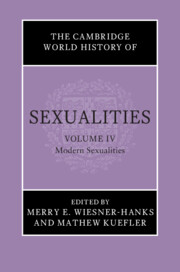Refine search
Actions for selected content:
54 results
6 - The Imperative of Professional Dementia Care
-
- Book:
- Relating to People Living with Dementia as Equals
- Published online:
- 12 December 2025
- Print publication:
- 22 January 2026, pp 111-132
-
- Chapter
- Export citation
8 - Dementia, Equality, and the Law of the United Kingdom
-
- Book:
- Relating to People Living with Dementia as Equals
- Published online:
- 12 December 2025
- Print publication:
- 22 January 2026, pp 152-167
-
- Chapter
- Export citation
7 - Can the Secure Dementia Unit Be Justified?
-
- Book:
- Relating to People Living with Dementia as Equals
- Published online:
- 12 December 2025
- Print publication:
- 22 January 2026, pp 133-151
-
- Chapter
- Export citation
Case 3.1 - White Privilege at the Work Opportunity Center
- from Part III - Case Studies in Mezzo-Level Practice
-
-
- Book:
- Critical Race Theory in Action
- Published online:
- 25 October 2025
- Print publication:
- 13 November 2025, pp 61-69
-
- Chapter
- Export citation
Chapter 14 - Members’ rights and remedies
-
- Book:
- Contemporary Australian Corporate Law
- Published online:
- 11 September 2025
- Print publication:
- 25 September 2025, pp 446-492
-
- Chapter
- Export citation

Kant on Social Suffering
-
- Published online:
- 28 July 2025
- Print publication:
- 21 August 2025
-
- Element
- Export citation
Beyond Boundaries: Ethnicity, Gender, and Class in Exod 1:8–2:10
-
- Journal:
- Harvard Theological Review / Volume 118 / Issue 2 / April 2025
- Published online by Cambridge University Press:
- 30 July 2025, pp. 203-221
- Print publication:
- April 2025
-
- Article
- Export citation
4 - Identifying the Elements and Legal Content of the Right
- from Part I - The Concept
-
- Book:
- The Human Right to Resist in International and Constitutional Law
- Published online:
- 20 February 2025
- Print publication:
- 27 February 2025, pp 76-112
-
- Chapter
- Export citation
Chapter 7 - Schopenhauer’s Political World
-
- Book:
- Schopenhauer's Politics
- Published online:
- 09 January 2025
- Print publication:
- 23 January 2025, pp 220-243
-
- Chapter
-
- You have access
- Open access
- HTML
- Export citation
The Moral Obligation to Resist Complacency about One’s Own Oppression
-
- Journal:
- Journal of the American Philosophical Association / Volume 11 / Issue 2 / June 2025
- Published online by Cambridge University Press:
- 13 January 2025, pp. 374-392
-
- Article
-
- You have access
- Open access
- HTML
- Export citation
1 - “It’s Just a Few Bad Apples”: The Denial of Systemic Inequality
-
- Book:
- Benign Bigotry
- Published online:
- 22 November 2024
- Print publication:
- 05 December 2024, pp 16-53
-
- Chapter
- Export citation
19 - Jesus, Power, and the Global Poor
- from Part IV - The Global Jesus Today
-
-
- Book:
- The New Cambridge Companion to Jesus
- Published online:
- 15 November 2024
- Print publication:
- 05 December 2024, pp 313-329
-
- Chapter
- Export citation
17 - The Ethical and Political Vision of Isaiah
- from Part IV - Afterlives of the Book of Isaiah
-
-
- Book:
- The Cambridge Companion to the Book of Isaiah
- Published online:
- 08 November 2024
- Print publication:
- 21 November 2024, pp 281-296
-
- Chapter
- Export citation
Silence and Listening
-
- Journal:
- Dialogue: Canadian Philosophical Review / Revue canadienne de philosophie / Volume 63 / Issue 2 / August 2024
- Published online by Cambridge University Press:
- 18 November 2024, pp. 263-276
-
- Article
-
- You have access
- Open access
- HTML
- Export citation
Conclusion
-
- Book:
- Out of Her Mind
- Published online:
- 10 October 2024
- Print publication:
- 10 October 2024, pp 256-262
-
- Chapter
- Export citation

The Cambridge World History of Sexualities
-
- Published online:
- 26 April 2024
- Print publication:
- 16 May 2024
Chapter 2 - The Theology of the Book of Nahum
-
- Book:
- The Theology of the Books of Nahum, Habakkuk, and Zephaniah
- Published online:
- 28 March 2024
- Print publication:
- 04 April 2024, pp 24-103
-
- Chapter
- Export citation
Chapter 3 - The Theology of the Book of Habakkuk
-
- Book:
- The Theology of the Books of Nahum, Habakkuk, and Zephaniah
- Published online:
- 28 March 2024
- Print publication:
- 04 April 2024, pp 104-172
-
- Chapter
- Export citation

The Theology of the Books of Nahum, Habakkuk, and Zephaniah
-
- Published online:
- 28 March 2024
- Print publication:
- 04 April 2024
